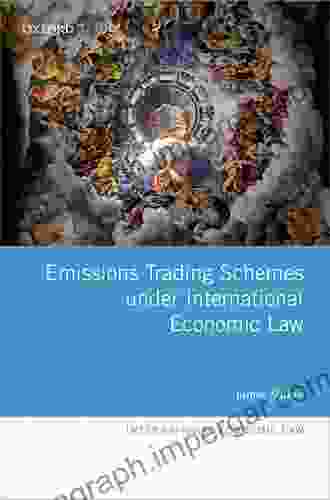Emissions Trading Schemes Under International Economic Law: A Comprehensive Guide

Emissions trading schemes (ETSs) have emerged as one of the key policy instruments for mitigating climate change. They represent a market-based approach to regulating greenhouse gas emissions, whereby entities are assigned or Free Download tradable permits that allow them to emit a certain amount of emissions. ETSs aim to create economic incentives for reducing emissions, while also ensuring that overall emission reduction targets are met.
5 out of 5
| Language | : | English |
| File size | : | 1594 KB |
| Text-to-Speech | : | Enabled |
| Screen Reader | : | Supported |
| Enhanced typesetting | : | Enabled |
| Word Wise | : | Enabled |
| Print length | : | 224 pages |
| Lending | : | Enabled |
The development and implementation of ETSs have been influenced by international economic law, which provides a framework for regulating trade and investment in a globalized economy. This article provides a comprehensive guide to emissions trading schemes under international economic law, covering their history, legal frameworks, implementation challenges, and future prospects.
History of Emissions Trading Schemes
The concept of emissions trading originated in the United States in the 1970s, with the establishment of the Clean Air Act. The first ETS was implemented in the European Union (EU) in 2005, and since then, ETSs have been adopted by a number of countries and regions around the world.
The evolution of ETSs has been closely tied to international climate negotiations. The Kyoto Protocol, adopted in 1997, established a framework for emissions trading under the Clean Development Mechanism (CDM). The CDM allows developed countries to invest in emissions reduction projects in developing countries, and to receive credits that can be used to offset their own emissions.
Legal Frameworks for Emissions Trading Schemes
The legal frameworks for ETSs vary depending on the jurisdiction in which they are implemented. However, there are some common elements that are typically included in ETS legislation:
- Emission caps: ETSs typically establish an overall cap on the total amount of emissions that can be released by covered entities.
- Permit allocation: Emissions permits are allocated to covered entities based on various criteria, such as historical emissions or economic activity.
- Trading platform: ETSs typically establish a trading platform where permits can be bought and sold.
- Monitoring and reporting: Covered entities are required to monitor and report their emissions on a regular basis.
- Enforcement: ETSs typically include provisions for enforcing compliance with the scheme's requirements.
Implementation Challenges
The implementation of ETSs has faced a number of challenges, including:
- Political opposition: ETSs have sometimes faced opposition from industries that are heavily reliant on fossil fuels.
- Administrative complexity: ETSs can be administratively complex to design and implement, particularly in jurisdictions with a large number of covered entities.
- Market volatility: The price of carbon credits can be volatile, which can create uncertainty for businesses and investors.
- Leakage: Emissions leakage can occur when covered entities reduce their emissions in one jurisdiction, but increase their emissions in another jurisdiction that is not covered by the ETS.
Future Prospects
Despite the challenges, ETSs are expected to continue to play an important role in mitigating climate change. The Paris Agreement, adopted in 2015, includes a commitment to "pursue efforts to limit the temperature increase to 1.5 degrees Celsius above pre-industrial levels." ETSs are one of the key policy instruments that can be used to achieve this goal.
In the future, ETSs are likely to become more integrated with other climate change policies, such as renewable energy targets and energy efficiency standards. ETSs are also likely to play a greater role in international climate cooperation, as countries seek to cooperate on reducing emissions and achieving the goals of the Paris Agreement.
Emissions trading schemes are a key policy instrument for mitigating climate change. They represent a market-based approach to regulating greenhouse gas emissions, whereby entities are assigned or Free Download tradable permits that allow them to emit a certain amount of emissions. ETSs have faced a number of implementation challenges, but they are expected to continue to play an important role in the fight against climate change.
This comprehensive guide has provided an overview of emissions trading schemes under international economic law, covering
5 out of 5
| Language | : | English |
| File size | : | 1594 KB |
| Text-to-Speech | : | Enabled |
| Screen Reader | : | Supported |
| Enhanced typesetting | : | Enabled |
| Word Wise | : | Enabled |
| Print length | : | 224 pages |
| Lending | : | Enabled |
Do you want to contribute by writing guest posts on this blog?
Please contact us and send us a resume of previous articles that you have written.
 Book
Book Novel
Novel Page
Page Chapter
Chapter Text
Text Story
Story Genre
Genre Reader
Reader Library
Library Paperback
Paperback E-book
E-book Magazine
Magazine Newspaper
Newspaper Paragraph
Paragraph Sentence
Sentence Bookmark
Bookmark Shelf
Shelf Glossary
Glossary Bibliography
Bibliography Foreword
Foreword Preface
Preface Synopsis
Synopsis Annotation
Annotation Footnote
Footnote Manuscript
Manuscript Scroll
Scroll Codex
Codex Tome
Tome Bestseller
Bestseller Classics
Classics Library card
Library card Narrative
Narrative Biography
Biography Autobiography
Autobiography Memoir
Memoir Reference
Reference Encyclopedia
Encyclopedia Jim Pipe
Jim Pipe Jeffrey A Hill
Jeffrey A Hill Joanna Leigh
Joanna Leigh Joel R Fried
Joel R Fried Jim Beloff
Jim Beloff Jeffrey E Brower
Jeffrey E Brower John Bisney
John Bisney Jimmy F Blackmon
Jimmy F Blackmon Joel Richard Paul
Joel Richard Paul John A Neuenschwander
John A Neuenschwander Jennifer R Wolkin Phd
Jennifer R Wolkin Phd Jerry V Diller
Jerry V Diller Jim Barrow
Jim Barrow Joe Lightfoot
Joe Lightfoot Jenn Mckinlay
Jenn Mckinlay Jeremy Jones
Jeremy Jones John Bandler
John Bandler Joe Buissink
Joe Buissink Jennifer Marshall Bleakley
Jennifer Marshall Bleakley Jeffrey St Clair
Jeffrey St Clair
Light bulbAdvertise smarter! Our strategic ad space ensures maximum exposure. Reserve your spot today!

 Raymond ChandlerFrom Broken to Blessed on the Bipolar Spectrum: A Transformative Journey of...
Raymond ChandlerFrom Broken to Blessed on the Bipolar Spectrum: A Transformative Journey of...
 Benji PowellUnveiling the Enchanting World of Ink Painting: The Body Art and Calligraphy...
Benji PowellUnveiling the Enchanting World of Ink Painting: The Body Art and Calligraphy... Julio CortázarFollow ·16.5k
Julio CortázarFollow ·16.5k Devin RossFollow ·7.6k
Devin RossFollow ·7.6k Floyd RichardsonFollow ·9.8k
Floyd RichardsonFollow ·9.8k Craig BlairFollow ·5.3k
Craig BlairFollow ·5.3k Braden WardFollow ·12.6k
Braden WardFollow ·12.6k Doug PriceFollow ·9.5k
Doug PriceFollow ·9.5k Cortez ReedFollow ·2.5k
Cortez ReedFollow ·2.5k William ShakespeareFollow ·7.8k
William ShakespeareFollow ·7.8k

 Christian Barnes
Christian BarnesUnleash Your Creativity: Build Interlocking 3D Animal and...
Discover the Art of Paper...

 Terry Bell
Terry BellUnveiling the Secrets of Winning: A Comprehensive Guide...
In the realm of chance and fortune, the...

 Albert Camus
Albert Camus101 Things That You Should Do Before Leaving The House In...
Starting your day right is...

 Anthony Burgess
Anthony BurgessForcing Move 2024 Volume: Unleash Your Inner Grandmaster
Embark on an extraordinary chess...
5 out of 5
| Language | : | English |
| File size | : | 1594 KB |
| Text-to-Speech | : | Enabled |
| Screen Reader | : | Supported |
| Enhanced typesetting | : | Enabled |
| Word Wise | : | Enabled |
| Print length | : | 224 pages |
| Lending | : | Enabled |











